
| WWT Shows | CLICK TO: Join and Support Internet Horology Club 185™ | IHC185™ Forums |

|
• Check Out Our... • • TWO Book Offer! • |
Welcome Aboard IHC185™  Internet Horology Club 185
Internet Horology Club 185  IHC185™ Discussion Site Main Page
IHC185™ Discussion Site Main Page  Interesting Horologically Based Stories
Interesting Horologically Based Stories  Larry Buchan's ..."Tales from the Rails"
Larry Buchan's ..."Tales from the Rails"  Canadian Pacific Railway's Spiral Tunnels
Canadian Pacific Railway's Spiral Tunnels
 Internet Horology Club 185
Internet Horology Club 185  IHC185™ Discussion Site Main Page
IHC185™ Discussion Site Main Page  Interesting Horologically Based Stories
Interesting Horologically Based Stories  Larry Buchan's ..."Tales from the Rails"
Larry Buchan's ..."Tales from the Rails"  Canadian Pacific Railway's Spiral Tunnels
Canadian Pacific Railway's Spiral TunnelsPage 1 2
Go  | New Topic  | Find-Or-Search  | Notify  | Tools  | Reply to Post  |  |
| Railway Historian IHC Life Member Site Moderator |
Sign at Spiral Tunnel Lookout. 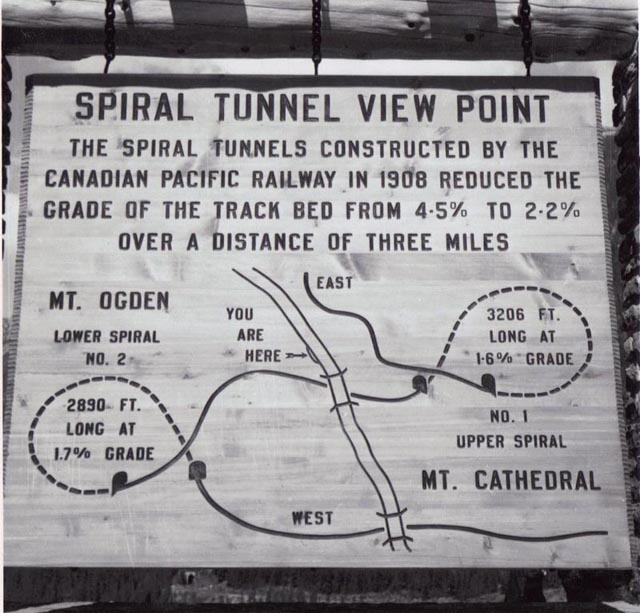 | ||
|
| Railway Historian IHC Life Member Site Moderator |
INTRODUCTION Well I've got my old trusty Hamilton wound up, and it's time for another tale from the rails. When the Canadian Pacific Railway was being completed in 1883 they were in financial difficulty. The route on the west side of the Continental divide proposed a great problem with its steep grades. In order to save money a temporary line was built with grades of 4.4% this was called the Big Hill it ran from Stephen at the Continental divide to the railway community of Field a distance of 7 miles. Field was named after Cyrus W. Field a Chicago businessman who built the Transatlantic cable, and who the CPR hoped would become an investor in the company. Standard locomotives were 4-4-0s but were of little use on the big hill Baldwin Locomotive Works were called upon to build 2-8-0s for use as Field pusher engines in 1884, at the time they were the most powerful locomotives built. The CPR began building its own 2-8-0s in August 1897. The big hill which was supposed to be temporary was to remain the main line for 25 years until the Spiral Tunnels were opened on September 1, 1909. The project was started in 1907, the route was decided upon and two tunnels were driven and three quarters circles into the valley walls the upper tunnel No. 1 ran under Cathedral Mountain emerging 50 feet below itself. Descending the valley side after its three quarter turn the track crossed the Kicking Horse River and entered Mount Ogden, the lower tunnel No.2 was shorter than No.1 by a few feet and the descent was again about fifty feet this route doubled the length of the climb and reduce the ruling grade from 4.4% to 2.2%. The labor force involved a thousand men, and cost 1.5 million Canadian dollars. Spiral Tunnel viewpoint train order signal. | |||
|
| Railway Historian IHC Life Member Site Moderator |
Spiral Tunnel No.2 from viewpoint. 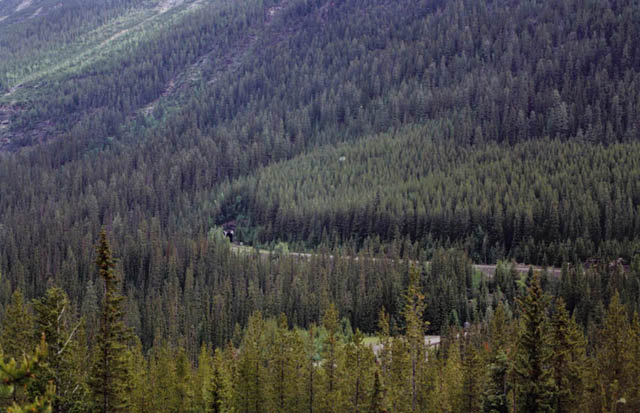 | |||
|
| Railway Historian IHC Life Member Site Moderator |
Town of Field British Columbia, 1979. Remains of Roundhouse, Station in top of view, snowplows in the yard ready for winter. Train of empty empty sulfur hoppers departing eastward for Calgary, Alberta. | |||
|
| Railway Historian IHC Life Member Site Moderator |
This picture presentation will show you part of the daily winter operations through Spiral Tunnel No.2, the date is February 20, 1980. At this time I was a qualified locomotive engineer working as an engine service brakeman, and on this particular trip I worked the tail end with conductor Fred Ramsey. The previous evening we had worked from Calgary to Field on train #67, we were called at 18:00 and were off duty at 00:35. We had the night in bed and were called for train XT (Toronto empties) at 11:30 our locomotive engineer was Louis Hlasny, and our power was 5854, 5535, 5664, 5610 all 3000 hp General Motors SD40 & SD40-2 6 axle locomotives, quite a leap in technology from the old steam locomotives that used to work out of Field. Our trip home was 135 miles and I took these pictures from the caboose on our way east from Field, it was a good trip and we were home and off duty at 18: 30 our total of 24 hours 30 minutes. We once again had conquered Field Hill through the Spiral tunnels a distance of 14 miles to the Continental divide at Stephen. I dedicate this presentation to my father Herman Noble Buchan who would have been 100 years old today November 30, he passed away prematurely from Alzheimer's 20 years ago. He taught me a love of the Rocky Mountains at an early age when he started his mountain climbing adventures at the age of 51. | |||
|
| Railway Historian IHC Life Member Site Moderator |
Leaving Field British Columbia, our caboose has just cleared the yard at the East switch. 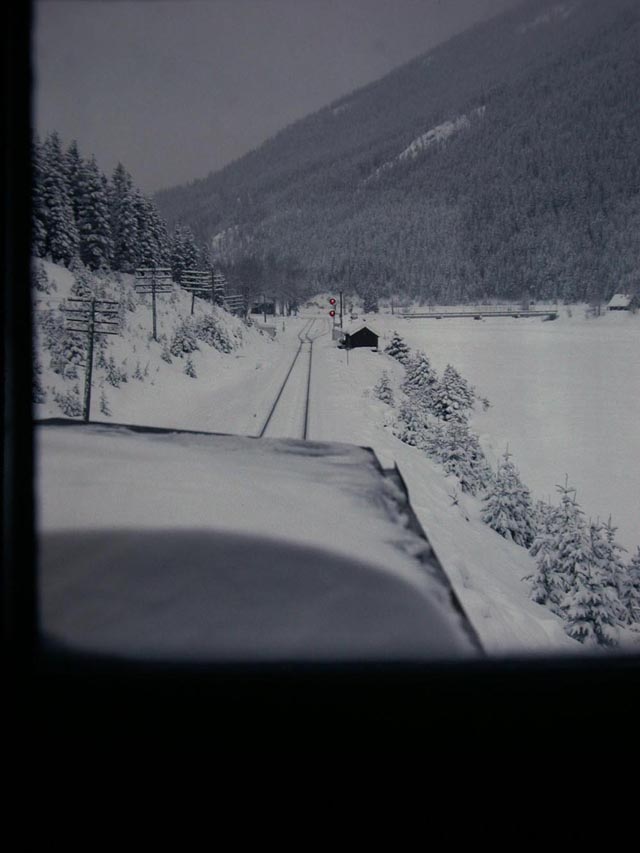 | |||
|
| Railway Historian IHC Life Member Site Moderator |
Looking East Mount Stephen looms in the foreground, and ascent of Field Hill begins. | |||
|
| Railway Historian IHC Life Member Site Moderator |
Caboose approaches intermediate signal, snow shed, and small tunnel through the nose of Mount Stephen. The head end crew has advised us we will be taking the siding at Cathedral for a westbound grain train. There are two sidings on Field Hill one at Cathedral below The Spiral Tunnels and one at Partridge above tunnel No.1 | |||
|
| Railway Historian IHC Life Member Site Moderator |
Train going through large snow shed on Mount Stephen, this is an area where many rockslides have come down over the years. | |||
|
| Railway Historian IHC Life Member Site Moderator |
Train taking siding at Cathedral, or train Symbol XT (Toronto empties) is a mix of empty tanks, Hoppers, gondolas, flat and boxcars heading for Toronto and other destinations east of Calgary. | |||
|
| Railway Historian IHC Life Member Site Moderator |
Caboose clear of mainline at Cathedral | |||
|
| Railway Historian IHC Life Member Site Moderator |
Westbound arrives at Cathedral, Train Dispatchers located in Calgary control all meeting points, and it's up to their discretion who takes the siding, with the exception of the two sidings at Cathedral and Partridge on Field Hill here the heavier loaded Westbounds always hold the main line. | |||
|
| Railway Historian IHC Life Member Site Moderator |
Westbound passes at Cathedral. TransCanada highway passes overhead. | |||
|
| Railway Historian IHC Life Member Site Moderator |
Leaving Cathedral cabooses pass each other, Train crews exchange signals saying all is okay with the westbound. | |||
|
| Railway Historian IHC Life Member Site Moderator |
Train crossing trestle over the Kicking Horse River | |||
|
Larry, As usual your stories are great and the pics are fantastic. | ||||
|
| Railway Historian IHC Life Member Site Moderator |
Train enters Spiral Tunnel No.2 | |||
|
| Railway Historian IHC Life Member Site Moderator |
Locomotives emerging from top portal of Spiral Tunnel No.2 | |||
|
| Railway Historian IHC Life Member Site Moderator |
Caboose about to enter the darkness of Spiral Tunnel No.2 | |||
|
| Railway Historian IHC Life Member Site Moderator |
Well the cabooses have disappeared from North America's railroading landscape, so our journey ends. Here is a proto-type of a bronze Centennial memorial plaque they plan to place on all the tunnels portals. Hope you enjoyed the journey. 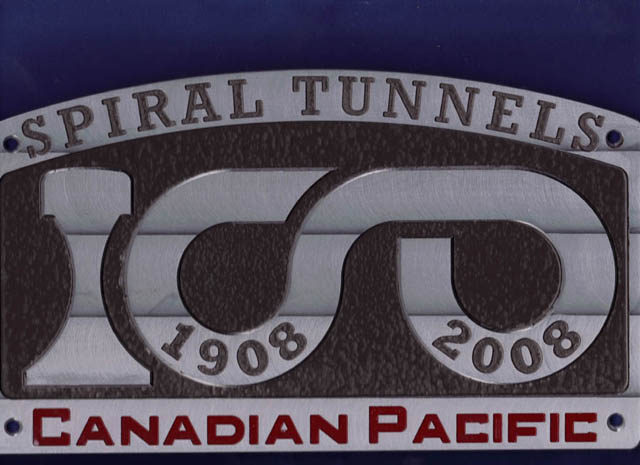 | |||
|
Larry Great pictures and story ! As rail fan and retired BNSF Siganl Maintainter, I was wondering if there was a fan exhaust system on both tunnels or how did they handle the fumes. I have seen the tunnels several times. FASCINATING !!! What was your home terminal and did you go both directions from it. I was just wondering if Field was a terminal or if it was Golden.? Thanks Bill Carlson | ||||
|
| Railway Historian IHC Life Member Site Moderator |
Hello Bill: There were no ventilating fans in the CPR's Spiral Tunnels, the old-timers who worked in the steam era, especially in pusher service, or on doubleheaders were subject to lots of smoke in the cabs of their locomotives. What they used to do would be to wet down a handkerchief with water and lay on the floor of the locomotive cab to help alleviate the effects of the heavy smoke through the tunnels. The Connaught tunnel under the Rogers's Pass it was built and opened in 1916 at over 5 miles long, at that time it was the longest railway tunnel in North America, and it was equipped with ventilator fans that were powered by diesel engines. Originally, the tunnel was double tracked, until dimensional changes in rolling stock required it to be made into singletrack in the 1960s. The new CPR Mount MacDonald which is about 9 miles long is the longest tunnel in the Americas it has and unique ventilating system with a shaft driven from tdown forhe top of the mountain to the half way point of the tunnel, it has doors at each portal and in the middle that forces air at a train entering from the East portal as the train passes the midpoint of the tunnel the midpoint door closes and the door on the West portal opens to allow fresh air past the train until it emerges from the West portal. The Rogers Pass runs under the Selkirk Mountains west of Golden and east of Revelstoke B.C.. My home terminal was Calgary, Alberta we used to work the Laggan Subdivision 136 miles west to Field, British Columbia, and the Brooks Subdivision 172 miles east to Medicine Hat, Alberta. Field, British Columbia, was intermediate crew change off point, and crews from Revelstoke, British Columbia worked 110 miles west. Golden was not a divisional point, but it was an important junction where a lot of coal traffic came up from southern British Columbia for export to Japan through Vancouver. I was a great railfan myself, and really enjoyed traveling through Montana with all its rich railroad history having the Northern Pacific, Great Northern, and Chicago Milwaukee St. Paul and Pacific railroads running through that state. I used to attend the railroad show in Helena, and Livingston every spring and the fall show in Missoula. I have attached a postcard scene showing the ventilating fan rooms on the Connaught Tunnel when the tunnel was double tracked, the small railway spur on the right side of the picture was for spotting tank cars of diesel fuel to provide power for the fans motors. Larry  | |||
|
Larry, Thank you so much! I really enjoyed the pictures and descriptions. Bob | ||||
|
| IHC Member 1110 |
Larry, This must have been one huge undertaking to build especially back then.Really facinating story and pictures.I just searched this on YouTube, and there's some great video shot from a lead CPR loco.It's almost as good as being there!I don't know if it's an illusion or not, but it looks barely wide enough for the train to pass through, doesn't even look wide enough for someone to stand alongside while a train is in there.They'd have a huge problem if there was a derailment or mechanical breakdown in there! Thanks again Larry!....Ted. | |||
|
Theodore I can speak from personal experience that you can stand in the tunnel and there is enough room for you and the train,and if you flattened your back to the tunnel wall and covered your face in case any stuff was hanging from the boxcars. I worked one summer in 1961, removing the wooden timbers that had been used to shore up the rock and replace it with cement. The project started in the mid 50's lasted 8 years. They could only work from April to October and no train could be delayed. We would remove about 200' of the old lumber at a time and then replace it with gunite. We would go through 1400 bags of cement a day, all of which had to be manhandled from the siding down below. Victor | ||||
|
| Railway Historian IHC Life Member Site Moderator |
Great story Victor, I remember the old-time engineers telling me stories of making trips through the tunnels and having wooden timbers falling from the roof onto their trains or on the track in front of them. In my era the cement work you did was a great improvement although there were chinks in the armor. There were lots of natural springs that leaked through the concrete year-round and in the winter icicles would form from the tunnel roofs, so passenger train locomotives on The Canadian were equipped with icebreakers on their roofs to break the icicles and prevent damage to the glass-enclosed dome cars. Also special boxcars were modified at the CPR's Ogden shops, the cars were filled with rock ballast for weight, and steel bulkheads were fabricated and welded to the roofs, these cars were kept in Calgary's Alyth yard and were placed on the head end of freight trains behind the locomotives for the purpose of icebreaking on through freights that were carrying open Multi-deck automobile carriers, this saved the company a lot of money for claims on broken glass windows. There was also an old siding between the two spiral tunnels called Yoho that had been relegated to a storage track, and in the winter months about two dozen boarding cars were stationed there with a gang whose duties were to control ice build up on the two tunnel walls that could be quite thick. This was continued until the 1990's when better technology made it possible to seal the leaks permanently. Photo from the interior of the top Spiral Tunnel 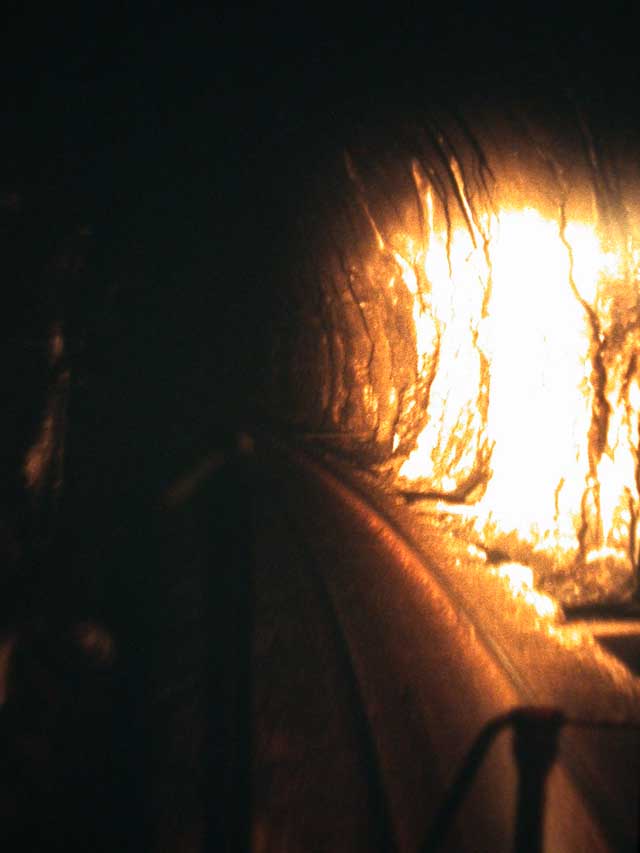 | |||
|
| IHC Member 163 |
Everytime I scroll through this thread, I can almost feel the cold air in my face and smell the diesel fumes from the engines, Larry. Thank you! HIGH regard! Mark | |||
|
| Railway Historian IHC Life Member Site Moderator |
Thank you Mark, here is another view showing some of the old timber work Victor referred to that is still in place on the West portal of Spiral Tunnel No.1. Larry | |||
|
| Railway Historian IHC Life Member Site Moderator |
Here is a view of the East portal of Spiral Tunnel No. 2 that I took in the summer of 1979, notice the additional oil covered rail that ends just outside the tunnel portal and is fastened between the two rails. This is called a Jordan rail, and is used as a safety measure in the event of the derailment inside of the tunnel, the idea being that the derailed wheels will butt up against the Jordan rail and the cars would not strike the walls of the tunnel. Double Jordan rails are also use on railway trestles to minimize damage to the structures. _eastbound.jpg) | |||
|
| Railway Historian IHC Life Member Site Moderator |
Here is a photo taken by CPR's Corporate Photographer Nicholas Morant, it shows a westbound freight approaching the upper portal of Spiral Tunnel No.2 and you can see Cathedral Crags framed by the portal of the tunnel. 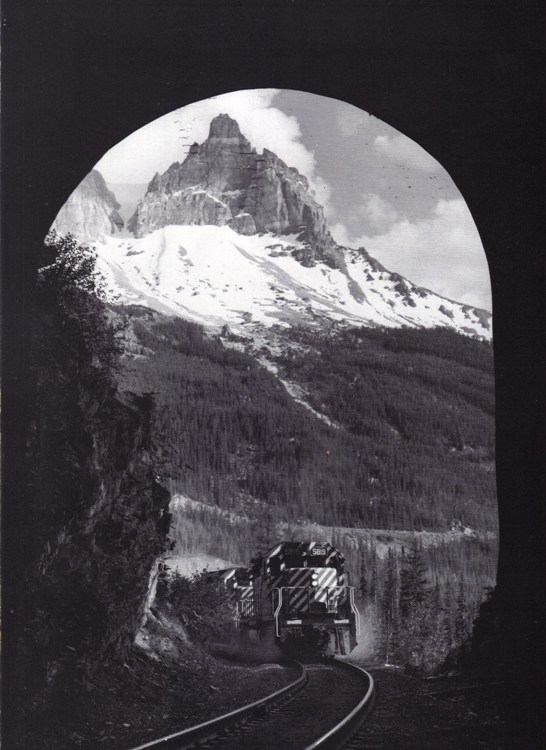 | |||
|
| Railway Historian IHC Life Member Site Moderator |
Here is another photo taken by Nicholas this one shows an eastbound freight approaching the lower portal of Spiral Tunnel No. 2 with Mount Stephen framed by the portal of the lower tunnel. These photos are taken from John Garden's book published by Footprint printing titled "Nicholas Morant's Canadian Pacific" a great book with superb photography of the Canadian Pacific Railway. This location is also quite famous for filming, as you emerge from the portal you get this stunning view of Mount Stephen. The location was used in filming David Lean's epic movie Dr. Zhivago in 1965, after the intermission there is darkness and a steam train supposedly operating in the Russian winter comes blasting out of the tunnel this was location where the scene was filmed, they also used other landmarks in the mountains of Alberta, and the winter wind swept prairies of Saskatchewan to simulate the bitter cold of a Russian winter, and the scenery they used was very realistic. 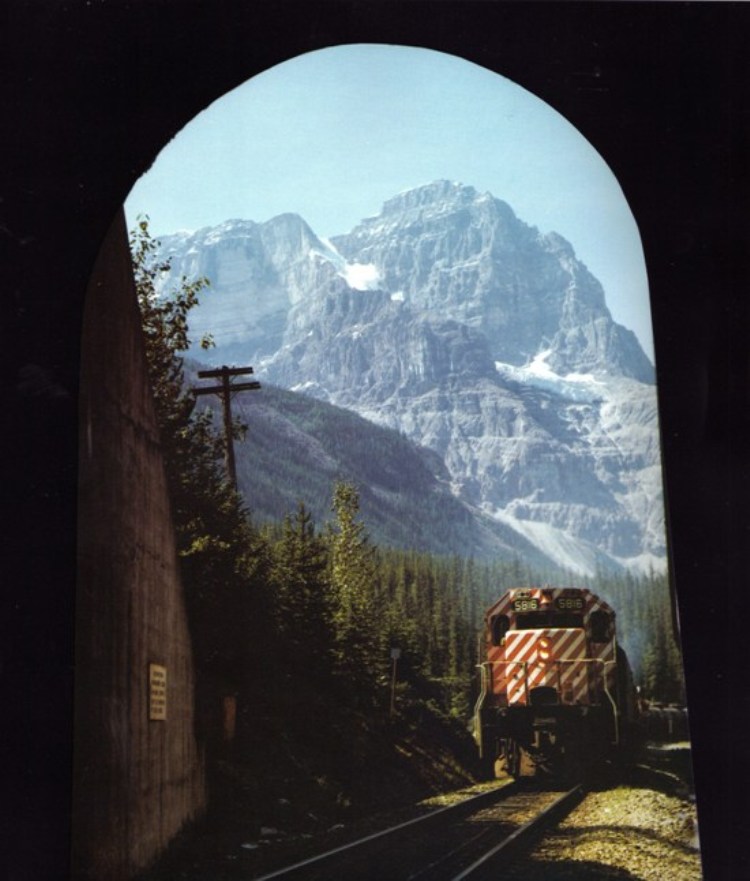 | |||
|
| Railway Historian IHC Life Member Site Moderator |
A postcard view showing an eastbound passenger train with pusher engines climbing Field hill in the early 1900's before the Spiral Tunnels were built, the grades from the summit of the Continental divide at Stephen down to Field, British Columbia were 4.5% the steepest on the CPR system, visible on the right-hand side is one of three safety switches that were installed on "The Big Hill" as a safety measure for westbound trains descending, switchtenders were stationed 24 hours a day at these locations and switches were always lined for the runaway track, the locomotive engineers on westbound trains had to whistle to notify the switchtender that their train was under control before he would line the switch for the descending grade, in spite of these safety measures there were still many runaways and derailments, and eastbound trains were limited in the amount of tonnage they could carry, and many crews and steam locomotives were needed for pusher service out of Field. 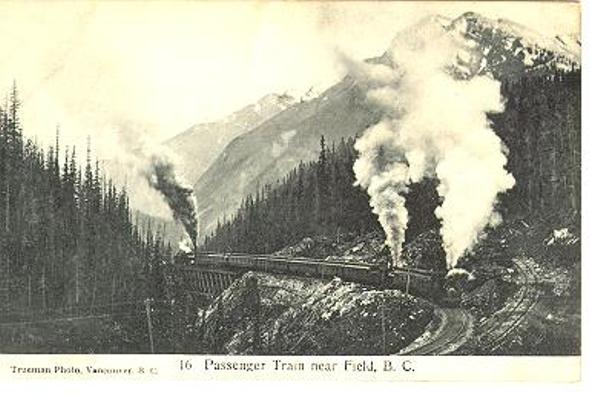 | |||
|
| IHC Vice President Pitfalls Moderator IHC Life Member |
Wonderful pictures and anecdotes Larry. This topic imparts a real sense of what Winter is like in the Canadian Rockies. Thanks so much for taking the time and trouble to share it with us. Best Regards, Ed | |||
|
| Powered by Social Strata | Page 1 2 |
| Your request is being processed... |
|
Welcome Aboard IHC185™  Internet Horology Club 185
Internet Horology Club 185  IHC185™ Discussion Site Main Page
IHC185™ Discussion Site Main Page  Interesting Horologically Based Stories
Interesting Horologically Based Stories  Larry Buchan's ..."Tales from the Rails"
Larry Buchan's ..."Tales from the Rails"  Canadian Pacific Railway's Spiral Tunnels
Canadian Pacific Railway's Spiral Tunnels
 Internet Horology Club 185
Internet Horology Club 185  IHC185™ Discussion Site Main Page
IHC185™ Discussion Site Main Page  Interesting Horologically Based Stories
Interesting Horologically Based Stories  Larry Buchan's ..."Tales from the Rails"
Larry Buchan's ..."Tales from the Rails"  Canadian Pacific Railway's Spiral Tunnels
Canadian Pacific Railway's Spiral Tunnels©2002-2025 Internet Horology Club 185™ - Lindell V. Riddle President - All Rights Reserved Worldwide

